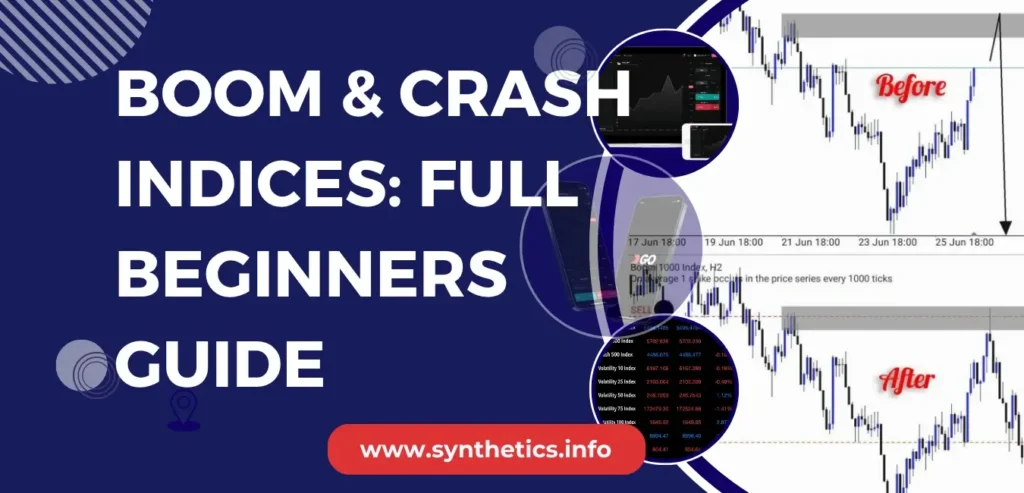When I first encountered Boom and Crash indices on Deriv, their unique behavior intrigued me. Unlike traditional forex pairs, these synthetic instruments offered predictable spikes — Boom indices with sudden upward movements, and Crash indices with sharp downward drops.
That kind of movement, combined with 24/7 access, made them especially appealing to traders in South Africa, Nigeria, Zimbabwe, Kenya, and Botswana. You could trade anytime — no news shocks, no economic reports — just price and chart.
But let me be real: navigating these charts wasn’t easy at first. I blew accounts trying to catch spikes I didn’t fully understand. Timing felt random, entries got wicked out, and it took time to grasp the structure behind the moves.
If you’ve ever looked at Boom or Crash charts and thought:
“How does that even happen?”
“Can I trade this with $10?”
“Is there a trick to catch spikes instead of being caught by them?”
You’re not alone.
In this guide, I’ll show you how Boom and Crash indices actually work, how to pick the right pair, and when to trade them.
I’ll also link you to PDF strategies, scalping setups, and my full market structure breakdown — so you stop trading blind and start trading with context.
🔗 Quick Access Links (Open in New Tab)
🔍 What Are Boom & Crash Indices?
Boom and Crash indices are synthetic instruments offered exclusively by Deriv.
They simulate explosive price movements in one direction — Boom spikes upward, Crash drops downward — after an average number of ticks.
These indices behave like a rising (booming) or falling (crashing) market, but they’re not tied to real-world assets or news events. Instead, they’re powered by a secure random generator, allowing for predictable spike behavior and 24/7 trading access.
| Type | Behavior |
|---|---|
| Boom Index | Spikes upward every 300, 500, 1000 ticks |
| Crash Index | Drops sharply downward every 300, 500, 1000 ticks on average |
👉 New to synthetic indices in general? Read the full breakdown here:
➡️ What Are Synthetic Indices on Deriv?
 Read Review
OPEN AN ACCOUNT
Read Review
OPEN AN ACCOUNT
Min Deposit: USD 1
Total Pairs: 100+
Regulators: MFSA, LFSA, VFSC, BVIFSC
📊 Types of Boom and Crash Indices Offered by Deriv (2025)
Deriv provides a range of Boom and Crash indices, each designed to simulate specific market behaviors. These synthetic indices are characterized by their unique tick intervals, indicating the average frequency of spikes or drops.
Boom Indices
| Index | Average Spike Interval |
|---|---|
| Boom 300 Index | Every 300 ticks |
| Boom 500 Index | Every 500 ticks |
| Boom 600 index (new) | Every 600 ticks |
| Boom 900 Index (new) | Every 900 ticks |
| Boom 1000 Index | Every 1000 ticks |
Crash Indices
| Index | Average Drop Interval |
|---|---|
| Crash 300 Index | Every 300 ticks |
| Crash 500 Index | Every 500 ticks |
| Crash 600 Index (new) | Every 600 ticks |
| Crash 900 Index (new) | Every 900 ticks |
| Crash 1000 Index | Every 1000 ticks |
Each Boom and Crash index moves differently — some spike constantly, others build up slow pressure before exploding.
💥 Boom 300 and Crash 300 move fast and often. I trade it when I want high-frequency setups and constant action.
🐢 Boom 1000 and Crash 1000 are slower but have bigger spikes. If you are the type of trader who waits for clean structure and bigger plays this may be for you.
👉 Want a full breakdown of Boom 1000?
Check out the complete Boom 1000 Index Guide – includes spike stats, session timing, and proven strategies.
Bottom line? Know your rhythm. Pick the index that matches your strategy and trading personality — not just the one that looks exciting.

🆕 What’s New: Boom 600 & Crash 900
Deriv recently introduced Boom 600 and Carsh 900 to bridge the gap between the classic 300/500/1000 tick intervals. These indices offer more flexible spike timing, giving traders new volatility profiles to work with.
Currently, they’re only available on the Deriv cTrader platform — not on MT5 or Deriv X.
⚠️ Heads up: Because of their different spike behavior, you may need to adjust your strategy. Always test on a demo account first before trading live.
🔍 What Makes Boom & Crash Indices Unique?
Boom and Crash indices are different from forex or even other synthetic pairs — and that’s exactly what makes them so powerful.
Here’s what sets them apart:
✅ They Move in Ticks, Not Pips
Every price change is measured in ticks, not pips. That means movement is faster and more precise — perfect for scalping strategies and tight entry setups.
⚡ Designed for Spikes
Boom and Crash indices are built to spike in one direction — Boom spikes up, Crash drops down. These sharp moves can happen in seconds, creating huge opportunities — but also requiring tight risk control.
🧪 100% Synthetic, 100% 24/7
Unlike forex, Boom & Crash indices don’t react to news, politics, or economic data. They’re powered by a random number generator and are available 24/7 — even on weekends.
🧠 If you’re looking for high-speed setups, clean chart movement, and zero news noise — Boom and Crash might be the perfect fit.
🌐 Which Brokers Offer Boom & Crash Indices?
If you’re searching for a Boom 1000 broker, Boom 500 index broker, or Crash 1000 index broker — there’s only one answer: Deriv.
🔹 Deriv – The Original & Only Boom and Crash Broker
Deriv is the sole broker that offers real Boom and Crash indices — including:
- Boom 1000, Boom 500, Boom 300
- Crash 1000, Crash 500, Crash 300
That’s because Deriv owns the actual algorithm that powers these indices. They’re not just mimicking price behavior — they created it.
No other broker has access to this algorithm or the exact spike engine. That’s why Deriv is the only real Boom and Crash broker. All others are simply trying to replicate the experience.
✅ If you’re looking for a verified Boom 1000 index broker or Crash 500 broker — Deriv is it.
🔗 Visit Deriv – Open a Boom & Crash Account Now
🔹 Weltrade – Offers Lookalike Synthetic Indices
Some brokers like Weltrade now offer their own synthetic pairs — such as Pain X 400 and Gain X 400 — which attempt to mirror the spike/dump behavior of Boom and Crash.
But here’s the truth:
- These are experimental, not established
- Many copycat indices have vanished in the past
- They don’t offer the same consistency or trust as Deriv
If you want to try alternatives, treat them as a sandbox — not a replacement for real Boom and Crash trading.
🔗 Check out Weltrade’s synthetic indices here

🧾 How to Trade Boom & Crash (Step by Step)
- Create a Deriv account → Open here
- Add a Financial MT5 account (not synthetic)
- Fund your account (USD, crypto, payment agents)
- Login to MT5 and search for “Boom” or “Crash”
- Place your trade using proper lot size + SL
Need help with setting up MT5? Read: How to Trade Synthetic Indices on MT5
⚖️ Minimum Lot Sizes for Boom & Crash Indices
Lot size controls how much you’re risking per trade — and with Boom & Crash indices, Deriv has a fixed minimum you need to know before opening a position.
Each Boom & Crash index has its own minimum lot size. Most are set at 0.20, but Boom 300 and Crash 300 are exceptions — with much higher minimums of 1.00 and 0.50 respectively.
| Index | Minimum lot size |
|---|---|
| Boom 1000 | 0.20 |
| Boom 500 | 0.20 |
| Boom 300 | 1 |
| Crash 1000 | 0.20 |
| Crash 500 | 0.20 |
| Crash 300 | 0.50 |
📌 You cannot trade Boom & Crash with $1. You’ll get “not enough money” errors unless your balance covers both margin and drawdown room.
👉 Want to understand how lot size affects your risk and stop loss across all synthetic indices?
Check out our full guide here: Lot Sizes for Synthetic Indices
📏 How to Calculate Ticks on Boom and Crash Indices
Ticks are the smallest price movements on Boom and Crash indices — and understanding how to calculate them is key to measuring your trade precision, stop loss, and profit targets.
🔢 What Is a Tick?
On Deriv’s Boom and Crash indices, 1 tick = 0.01. So every time the price moves by 0.01, that’s considered one tick.
🧠 Step-by-Step: Calculating Ticks
Let’s say price moved from 1000.50 to 1001.00 — how many ticks is that?
- Find the total movement:
1001.00 – 1000.50 = 0.50 - Use the tick value:
1 tick = 0.01 - Do the math:
0.50 ÷ 0.01 = 50 ticks
✅ So, a 0.50 move equals 50 ticks.
📌 Why This Matters
Knowing tick movement helps you:
- Set accurate stop loss and take profit levels
- Understand your risk in points vs dollar terms
- Avoid oversized trades, especially on small accounts

Boom & Crash Indices Minimum Deposit & Margin Requirements
You can deposit as little as $1 to your synthetic indices account. However, you will not be able to tradecrash boom indices with such a low account balance.
The margin requirements and the minimum lot sizes needed to trade boom and crash will not allow you to place trades with such a low balance.
Below are the margin requirements and the minimum account deposit needed to trade the different boom and crash indices.
| Boom & Crash Index | Margin requirements for 0.2 lot size | Minimum advisable account balance required |
|---|---|---|
| Boom 1000 Index | $6.01 | $10 |
| Boom 500 Index | $2.51 | $5 |
| Crash 1000 index | $3.53 | $5 |
| Crash 500 Index | $3.72 | $5 |
📈 How to Read Boom & Crash Charts
Don’t just look for spikes. Learn to read the structure.
✅ Price builds up before a spike — usually with:
- Higher lows (Boom) or lower highs (Crash)
- Tight candles or stalls at key zones
- Clean breakouts followed by retests
Avoid this mistake: Trading based on random spikes without understanding trend.
👉 New? Read: Boom & Crash Market Structure Guide
⏰ Best Time to Trade Boom & Crash
Boom & Crash indices run 24/7 — but volatility isn’t evenly spread across the clock.
🔹 Most indices spike hardest between 14:00–18:00 UTC
🔹 Quietest window: 01:00–05:00 UTC — low flow, messy structure
🔹 Some pairs like Boom 300N and Crash 300N even peak on Sundays
📊 Want the full weekday and session breakdown for all 10 indices?
➡️ See Best Time to Trade Boom & Crash Indices
🎯 Strategy Overview📘 Market Structure (for trend traders)
- Identify BOS (Break of Structure)
- Wait for retest
- Enter in direction of H1 trend
👉 Read the Full Guide
🧠 Scalping Strategy
- Use M1 entries at pullback zones
- Works best on Boom 500 and Crash 1000
👉 View Scalping Strategy
📥 PDF Strategy Pack
- Free downloadable setup sheet
- Includes entry/exit plans + screenshots
👉 Get the PDF
✅ Pros and Cons
🟢 Why Traders Love Boom & Crash
- Predictable spikes
- 24/7 trading (even on weekends)
- No news = no surprises
- Ideal for scalping and price action learners
🔴 What to Watch Out For
- Fast moves = fast losses if unprepared
- Minimum lot = 0.20 (no micro lots)
- Overtrading temptation is real

🧠 Final Take: My Real Advice on Boom & Crash
Boom and Crash might seem predictable — even easy — when you first look at the charts. But don’t let that fool you.
Every day, traders blow their accounts by chasing spikes, overtrading, or running five positions on a $10 balance.
The biggest mistake? Trying to guess when the next spike will hit. That rarely works long-term.
Instead, zoom out. Learn how each index moves. Study structure. Respect volatility.
Because once you stop guessing and start trading with a plan, these instruments become incredibly rewarding.
🎯 Discipline beats prediction. Every time.
💬 What’s Been Your Experience?
I’ve shared what I’ve learned from trading Boom and Crash over the years — the wins, the blown accounts, the setups that actually worked.
Now I want to hear from you.
👉 What’s been your experience with Boom and Crash indices?
- What strategy or tip gave you an edge?
- What burned you the most when you were starting out?
- If you could go back, what do you wish you knew from day one?
Drop your thoughts in the comments below — your insight might be exactly what another trader needs to hear right now.
Let’s learn from each other.

🔗 Related Guides
If this guide helped you, share it in your group chats or trading community. Let’s help more traders stop guessing and start trading smarter.
FAQs On Crash & Boom Indices
Yes, but only on Boom 500 / Crash 500 and with strict SL. Most pairs need $7–10+.
Boom and Crash are synthetic indices created by Deriv that simulate regular price spikes. Boom indices spike upward, while Crash indices spike downward.
Yes, you can start trading with as little as $5–$10. Just make sure to use proper lot size (0.20 minimum) and strict stop-loss settings to manage risk.
Boom 500 and Crash 1000 are ideal for beginners due to their moderate volatility and lower margin requirements compared to Boom 1000.
You can trade Boom & Crash on Deriv’s MT5 or cTrader platforms. Most traders use MT5 for charting and placing trades via a Financial Account







💼 Recommended Brokers to Explore
Other Posts You May Be Interested In
How To Open A Deriv Real Synthetic Indices Account in 2025 ☑️
📅 Last updated: June 12, 2025 ✍️ Written by: Jafar Omar ✅ Fact-checked by: Taylor [...]
Volatility Indices on Deriv: Full Guide to Types, Lot Sizes, Volatility Levels & Best Strategies (2025)
📅 Last updated: June 23, 2025 ✍️ Written by: Jafar Omar ✅ Fact-checked by: Taylor [...]
How To Use Deriv Payment Agents (Full Guide 2025) — Deposit, Withdraw, Agent List, CR Number, Become an Agent💰
📅 Last updated: June 21, 2025 ✍️ Written by: Jafar Omar ✅ Fact-checked by: Taylor [...]
HFM Copy Trading Review: ♻ Copy Top Traders Today!
📅 Last updated: November 24, 2023 ✍️ Written by: Jafar Omar ✅ Fact-checked by: Taylor [...]
Top 5 Best Free Deriv Binary Bots for Synthetic Indices (2025 Roundup) 🤖
📅 Last updated: June 23, 2025 ✍️ Written by: Jafar Omar ✅ Fact-checked by: Taylor [...]
Varus – Deriv Under 5 Bot with Safe PLS Recovery Strategy (2025)🤖
📅 Last updated: June 23, 2025 ✍️ Written by: Jafar Omar ✅ Fact-checked by: Taylor [...]